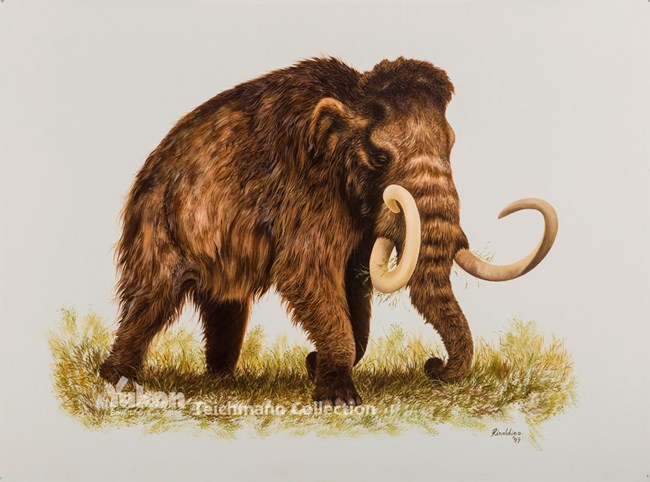
(Woolly Mammoth) © Government of Yukon / Artist George "Rinaldino" Teichmann (1999) One of the most iconic animals that made their home on the Bering Land Bridge was the woolly mammoth. Throughout Russia and Alaska, mammoth remains are plentiful, but mastodon remains are rare. What does this reveal about Bering Land Bridge's ecosystem? Called the tundra-steppe, it was the mammoth's perfect home, a cold grassland. But the mammoth wasn't alone on the tundra-steppe. Notice the large tusks? What do you think they were used for? 
NPS Photo Dig Deeper into the History of the Woolly Mammoth No creature more typifies or symbolizes the Pleistocene ice-age than the woolly mammoth. As its namesake suggests, this creature truly was an animal of mammoth proportions among the beasts to walk on the ice-age steppe. The creature holds so much fame and notoriety that paleontologists have even named an entire mammalian ecosystem after it: the mammoth steppe, i.e. the productive grasslands that swept across much of the northern latitudes of Pleistocene North America, Asia, and Europe. Though woolly mammoth remains account for only about five percent of the fossil record from ice-age Alaska, it is known that the creature constituted over a third of the ecosystem’s biomass with respect to mammals (Matheus, pp. 55). This was partly due to its sheer size and to the fact that it was one of the most common animals to be found on the ice-age steppe of Alaska. Modern Relatives The woolly mammoth, scientific name Mammuthus primigenius, is related to the modern African and Asian elephants. All three in fact, belonging to the subfamily of Elephantinae, are believed to have originated from Africa from a common ancestor who has been named Primelephas gomphotheroides (Noro, pp. 314). Recently however a joint scientific venture involving scientists from Hokkaido University in Japan and the Russian Academy of Sciences in Moscow, analyzed Ribosomal RNA gene sequences in all three species. Results of the study showed that the woolly mammoth is actually more closely related to the African elephant than to the Asian elephant (Noro, pp. 314). Diet, Appearance, and Behavior The ice-age woolly mammoth, in contrast to its present day African and Asian cousins, was strictly an herbivorous grazer as it could no doubt be found consuming bunches upon bunches of grass and vegetation (Matheus, pp. 55). With tusks weighing next to 200 pounds, each of which measuring well over twelve feet in length (Matheus, pp. 55), the woolly mammoth was as important a species in ice-age Alaska as any. Looking very much like a short elephant with a shaggy coat of insulating hair, the woolly mammoth had droopy hindquarters that eventually culminated to a domed shaped skull topped with a tuft of hair (Matheus, pp. 57). While its back end had a tiny hairy tail, – there would be no reason to have a long tail in such a cold climate as ice-age Alaska – its front end sported a bifurcated trunk that was split at the tip. Like the thumb and fingers of your hand, the trunk would easily grab the clumps of vegetation that could be found underfoot. Some postulate that the mammoth may have also used this very same technique to put snow in its mouth for water (Matheus, pp. 57). Both sexes carried a pair of ivory tusks which among other things, were used to display status and fitness. As has been observed amongst the behaviors of modern elephants, woolly mammoths are also believed to have engaged in heated physical battles often leading to fatal injuries. Evidence for this may in fact be shown in the fossil record seeing as how many fossilized mammoth tusks have been found broken, shattered, or worn (Matheus, pp. 57) though this is by no means any direct proof of such behavior. Archaeological Findings Much of the attention and notoriety that the woolly mammoth has garnered in recent years has come from archaeological findings of mammoth remains, particularly mummified remains. Many cases of mummified mammoth remains have taken place in Alaska and Russia. Mammoth mummies form when a specimen becomes buried by sediments relatively quickly following its death. At the same time, a rise in the permafrost table has to take place, at which point the carcass would freeze while suspended in a more or less preserved state on account of the sediments (Matheus, pp. 58). What results in turn, is the mummification. Over the course of millennia, the dry frozen soil sucks moisture out of the carcass, a process that University of Alaska at Fairbanks paleontology student Paul E. Matheus says is analogous to freezer burned meat. “Just imagine what an unwrapped moose steak would look like after being left in a freezer for 30,000 years (Matheus, pp. 58).” What you get ultimately, is a naturally mummified mammoth that is almost completely intact, save for the fact that it would be gnarled and deflated from eons of time under the frozen Earth. Many of the things which we now know about wooly mammoths would be nonexistent if this natural mummification process were not to have taken place. That is how the mammoth’s hand-like trunk and toupee-like tuft at the top of its head were discovered. Mummies from about ten other species of Pleistocene mammals have been discovered in Alaska including steppe bison, caribou, muskoxen, moose, voles, horses, lynx, hares, pikas, and ground squirrels. -Information found within this piece was accrued from research from the following publication(s): Matheus, Paul E. “Pleistocene Mammals.” Alaska Geographic. 1994: 21 Noro, Miyuki et. al. “Molecular Phylogenetic Inference of the Woolly Mammoth Mammuthus primigenius, Based on Complete Sequences of Mitochondrial Cytochrome b and 12S Ribosomal RNA Genes.” Journal of Molecular Evolution 23 July 1998: 46. <http://www.springerlink.com/content/r76t9cmcywjw1xdj/fulltext.pdf> |
Last updated: November 30, 2015
